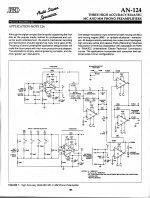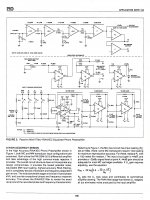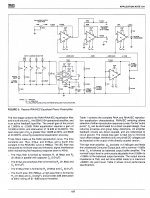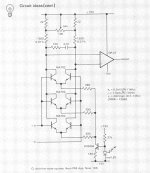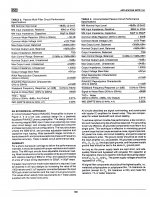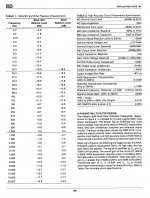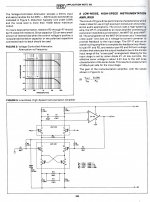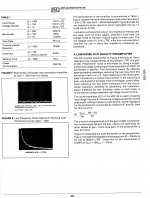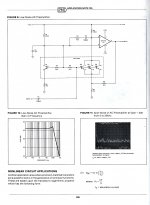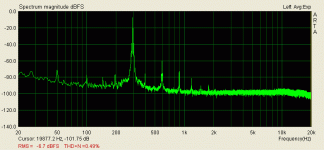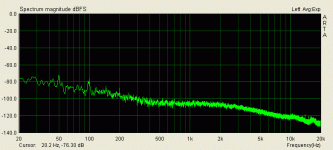Be careful of >50MHz opamps in a socket, the inductance is enough to turn them into oscillators. Twenty years ago we used to mount the turned pins directly into the pcb to improve this
socket to me is a pin to you....
Good point on the socket. There are low profile sockets also so that may be better.
Another point on the wide-bands is about any error in layout or supply bypass will make an oscillator instead of an amplifier. According to the design engineer I talked to at National Semi the slower (50mHz) wide band op amps have 5gHz transistors inside. That leaves a lot of room for trouble if good Radio Frequency habits are not practiced.
Be careful of >50MHz opamps in a socket, the inductance is enough to turn them into oscillators. Twenty years ago we used to mount the turned pins directly into the pcb to improve this
Good point on the socket. There are low profile sockets also so that may be better.
Another point on the wide-bands is about any error in layout or supply bypass will make an oscillator instead of an amplifier. According to the design engineer I talked to at National Semi the slower (50mHz) wide band op amps have 5gHz transistors inside. That leaves a lot of room for trouble if good Radio Frequency habits are not practiced.
Build your preamp with a socket so you may try any dual op-amp you like. A socket will not hurt the sound at all. Here is a good socket:
Digi-Key - ED3308-ND (Manufacturer - 110-93-308-41-001000)
Good sounding op amps:
NJM2068 LF353 LT1028
Bad sounding op amps:
NE5532 ??4558 LM833
beg to differ ..NE5532 has nothing to do with 4558 and 833..
It s an op amp of exceptionnal quality even it s an old one.
Just happen that many people don t know how and when using it.
with a ein of 4.5nV/sqrt hz, and distorsion of 0.0005% at most,
i would put it ahead of a 2068 that is 14nV/sqrt hz and 0.001% THD.
Last edited:
I use a lot of NE5534A and they are still excellent and a huge bargain.
Even the best of todays new OPs have only very slightly better performance in terms of distortion.
I whould not use it for an MC input but for MM it´s perfect because it has low current noise too, at least for a bipolar.
For exampe the new LME49710 has less voltage noise but 4 times the current noise.
The sound difference between those chips that are 30years apart in age is small provided the circuit, PSU and grounding is done correctly.
I used a subsonic filter with NE5534A buffers on CES in a 50.000,- $ system and show goers actually preferred the sound of the system with the filter in.
Even the best of todays new OPs have only very slightly better performance in terms of distortion.
I whould not use it for an MC input but for MM it´s perfect because it has low current noise too, at least for a bipolar.
For exampe the new LME49710 has less voltage noise but 4 times the current noise.
The sound difference between those chips that are 30years apart in age is small provided the circuit, PSU and grounding is done correctly.
I used a subsonic filter with NE5534A buffers on CES in a 50.000,- $ system and show goers actually preferred the sound of the system with the filter in.
beg to differ ..NE5532 has nothing to do with 4558 and 833..
It s an op amp of exceptionnal quality even it s an old one.
Just happen that many people don t know how and when using it.
with a ein of 4.5nV/sqrt hz, and distorsion of 0.0005% at most,
i would put it ahead of a 2068 that is 14nV/sqrt hz and 0.001% THD.
I never said the NE5532 was any relative of the 4558 or 833 other than its bad sound
Yes in 1973 when that thing came out it was pretty good. But like you I beg to differ. I throw away that old junk and replace with NJM2068 every time it is seen. Distortion is shown as 0.001% (-100dB) which is little different (6dB) than the -106dB of the 5532 at that tiny level and is therefore of no consequence.
Further, I have no idea where you came up with the noise information as the data sheet I have for the NE5532 says 12nV/√Hz which is the one in the Signetics data book the original manufacturer of that device. Also the NJM2068 is available in a graded version that is even quieter so I can only assume there is an error in your data.
Even better is to listen to them. Garmin avionics division has removed the 5532 from all avionic products because in real circuits the NJM2068 delivers vastly superior noise performance and it will drive the low Z load in real circuits much better than that old nasty sounding 5532 or its cousins 5533 and 5534.
For those of you who doubt any of this make a simple test jig with a socket and place it between your source and the amplifier and simply listen. This only works if there are no 5532 series in the signal path. It will be very easy to determine which is quieter in real circuits and very easy to determine which sounds like rain on a tin roof and which sound like music.
As far as a phono preamp do the same- use a socket and simply listen. The truth will be very apparent.
Testing in real life is the real way to know. Spec sheets are only paper.
The noise figures are typical values at 1khz bandwith for both circuits..
Here the pdf from philips which did buy signetics and its product portfolio.
The 5532 is showing 5nv√Hz with 1kHz typical
There is not an equivalent spec for the NJM2068 so that needs to be calculated from the noise voltage. square root 1000 is about 33 so 500/33 is 15 which is higher as you say "on paper." There is no noise current spec on the 2068. So yes the on paper spec is better. When I get my noise meter fixed (it just broke) I will measure both in circuit. The 5532 increases noise quite a lot at low frequency maybe more than the 2068.
Good for you to link to a socket. Nothing like a chance to compare directly in a real circuit. Sound wise in all my test these two are not even close. Try the 2068 in your circuits and see what you find.
Feb 25,1987 Signetics datasheet for NE/SA5533/5534A gives:
30 Hz 5.5/7 nV/sqrt(Hz) typ/max(A grade)
1 KHz 3.5/4.5
1 KHz 0.4 pA/sqrt(Hz) typ
there are differences by manufacturer, possibly fab cleanliness, process maturity or even just test conservatism - its strange that Phillips would have to relax the specs
at this late date there is little guarantee of what you’re getting with the “generic” 553x part # - it used a odd topology and likey newer redesigns differ internally
but the part isn’t totally hopeless – in the past decade audio DAC manufacturer’s have released reference designs for their “flagship” parts with noise and distortion specs better than 110 dB using 5534 op amps for output
for the thread’s op amp phono preamp application it isn’t a great choice – not even in the running for MC and many designers would go with Fet input for MM
30 Hz 5.5/7 nV/sqrt(Hz) typ/max(A grade)
1 KHz 3.5/4.5
1 KHz 0.4 pA/sqrt(Hz) typ
there are differences by manufacturer, possibly fab cleanliness, process maturity or even just test conservatism - its strange that Phillips would have to relax the specs
at this late date there is little guarantee of what you’re getting with the “generic” 553x part # - it used a odd topology and likey newer redesigns differ internally
but the part isn’t totally hopeless – in the past decade audio DAC manufacturer’s have released reference designs for their “flagship” parts with noise and distortion specs better than 110 dB using 5534 op amps for output
for the thread’s op amp phono preamp application it isn’t a great choice – not even in the running for MC and many designers would go with Fet input for MM
Last edited:
Somehow I don't think that a decades old spec. sheet is an accurate representation of current parts. Few IC's designed ages ago are still manufactured using the same dies and equipment.
Spec sheets in general are just bits of paper. There real result is the "in the circuit as used" test. Some circuit may work better with one op-amp and change a circuit then a different op-amp works better. This is why a socket should be used. All the likely candidates can be purchase and whatever testing desired may be completed.
As example, noise measurement can just be a mV AC meter on the output. Sound quality can be listened to. Distortion can be measured with equipment if that is a concern. Most all op-amp circuits will have distortion less than 0.1% which is far less than any normal speaker so that is often not a concern.
I truly prefer trying various op-amps and pick the one that sounds good to me and the other "golden rears" who are interested.
As example, noise measurement can just be a mV AC meter on the output. Sound quality can be listened to. Distortion can be measured with equipment if that is a concern. Most all op-amp circuits will have distortion less than 0.1% which is far less than any normal speaker so that is often not a concern.
I truly prefer trying various op-amps and pick the one that sounds good to me and the other "golden rears" who are interested.
Hi,
I am going in for the final assembly. Just waiting for my wooden case to be ready.
Best regards,
Bins.
I am going in for the final assembly. Just waiting for my wooden case to be ready.
Best regards,
Bins.
Ideas for RIAA phono front ends
For those looking to build a phono preamp the most sensible option would probably be the circuit in the NatSemi LME49710 application note AN-1651, although the Twisted Pear fully differential design elsewhere on this forum is appealing in its elegance.
But for those wishing to design their own, I have unearthed from the Dark Days of DOS, (PMI Apps 1986-90) a couple of PMI application notes for RIAA preamps which boast excellent performance, even today. PMI (Precision Monolithics Inc) made some excellent devices but was absorbed into Analog Devices in the 1990's. I have not been able to find these app notes on the web and so have scanned copies from the book I have.
The conventional op-amps in the circuits of AN-124 could be replaced directly with modern devices. But the circuits use the SSM2015, which is obsolete. In its day it was very popular in pro audio, especially analog mixing desks. The SSM2019 is still available and with a little effort may be suitably adapted to work in the circuits, but probably better performance can be obtained by making up a circuit block to replace the SSM2015. Some ideas for this may be found in PMI App note AN-105 and - the one I like best - in AN102 (reproduced from Horowitz & Hill).
Also, such a circuit block could potentially replace the first op-amp in the NatSemi AN-1651 circuit and improve SNR. This would be my choice.
I've been unable to reduce the file size of the scanned copies without compromising legibility and the pdf's are multi-megs, so I've attached them as jpgs, one page at a time
For those looking to build a phono preamp the most sensible option would probably be the circuit in the NatSemi LME49710 application note AN-1651, although the Twisted Pear fully differential design elsewhere on this forum is appealing in its elegance.
But for those wishing to design their own, I have unearthed from the Dark Days of DOS, (PMI Apps 1986-90) a couple of PMI application notes for RIAA preamps which boast excellent performance, even today. PMI (Precision Monolithics Inc) made some excellent devices but was absorbed into Analog Devices in the 1990's. I have not been able to find these app notes on the web and so have scanned copies from the book I have.
The conventional op-amps in the circuits of AN-124 could be replaced directly with modern devices. But the circuits use the SSM2015, which is obsolete. In its day it was very popular in pro audio, especially analog mixing desks. The SSM2019 is still available and with a little effort may be suitably adapted to work in the circuits, but probably better performance can be obtained by making up a circuit block to replace the SSM2015. Some ideas for this may be found in PMI App note AN-105 and - the one I like best - in AN102 (reproduced from Horowitz & Hill).
Also, such a circuit block could potentially replace the first op-amp in the NatSemi AN-1651 circuit and improve SNR. This would be my choice.
I've been unable to reduce the file size of the scanned copies without compromising legibility and the pdf's are multi-megs, so I've attached them as jpgs, one page at a time
Attachments
Last edited:
More attachments. . .
The rest of AN-124. AN102
The rest of AN-124. AN102
Attachments
Last edited:
Final attachments
And AN105.
The best phono preamps offer SNR of >90 dB for MM cartridges.
But what I would be interested to know, is has anybody - such as a turntable, cartridge or preamp manufacturer, or test house - ever done SNR measurements on a phonograph- cartridge-turntable combo playing a zero modulated vinyl disc? I'm guessing at about 70dB, unweighted 20-20kHz. Anyone know?
And AN105.
The best phono preamps offer SNR of >90 dB for MM cartridges.
But what I would be interested to know, is has anybody - such as a turntable, cartridge or preamp manufacturer, or test house - ever done SNR measurements on a phonograph- cartridge-turntable combo playing a zero modulated vinyl disc? I'm guessing at about 70dB, unweighted 20-20kHz. Anyone know?
Attachments
And AN105.
The best phono preamps offer SNR of >90 dB for MM cartridges.
But what I would be interested to know, is has anybody - such as a turntable, cartridge or preamp manufacturer, or test house - ever done SNR measurements on a phonograph- cartridge-turntable combo playing a zero modulated vinyl disc? I'm guessing at about 70dB, unweighted 20-20kHz. Anyone know?
Actually, the thermal noise of the cartridge may be higher than that... -70dB is pushing it. So from a noise standpoint, it really doesn't matter if the preamp is -75dB or -90dB.
Yes, I can believe that. In the early days of CD's 1980's I used to hear the figure 60dB bandied around by the 'Disciples of the New Faith'.
I run a couple of FFT for you. One is running the first 300Hz bias track on the HFNRR disc, next is left scratching the vinyl in the locked groove on its end.
That is with a 0.25mV 14 Ohm cart with 61dB gain phono stage, on a salvaged 80s Walker TT. 0dBV is 2V RMS on the charts. The 300Hz is at -6.5dB on the first one for 0.5% THD on +12dB groove modulation.
That is with a 0.25mV 14 Ohm cart with 61dB gain phono stage, on a salvaged 80s Walker TT. 0dBV is 2V RMS on the charts. The 300Hz is at -6.5dB on the first one for 0.5% THD on +12dB groove modulation.
Attachments
That's a pretty looking harmonic fall off, Salas! It should be next to inaudible.
Is that an FTT bin artifact, or is your TT a little slow?
Is that an FTT bin artifact, or is your TT a little slow?
Can't be sure of the ins and outs of those programs, looks 296.6Hz (3.4 Hz slower) with 65536 points on Arta, but on SpectraPlus with same analysis shows 297.92Hz for 300Hz. But calculates much less THD, 0.22%. It is a 27-30 yrs old belt driven without its original belt, and we don't know if the actual test record is helping a bit for that -2.08Hz or not. -0.69% pitch I can live with. Maybe I have read that Mr. Walker was tuning his TTs a tad slower but I can't surely recall.
- Status
- Not open for further replies.
- Home
- Source & Line
- Analogue Source
- Phono preamplifier using OPAMPS.
